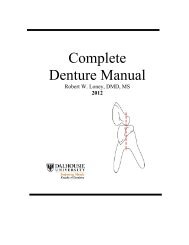RPD Manual 11 - Removable Prosthodontics - Dalhousie University
RPD Manual 11 - Removable Prosthodontics - Dalhousie University
RPD Manual 11 - Removable Prosthodontics - Dalhousie University
You also want an ePaper? Increase the reach of your titles
YUMPU automatically turns print PDFs into web optimized ePapers that Google loves.
Principles of Partial Denture Design - 68<br />
General Considerations<br />
Consider Soft Tissue Variables<br />
Soft tissue anatomy such as frenal attachments and vestibular depth can affect the choice of<br />
major connectors, and direct retainers. Characteristics of the soft tissues, such as undercuts and<br />
tissue compressibility of attached mucosa, may also affect design decisions. These aspects of the<br />
tissue need to be identified intraorally, since they can frequently not be determined solely on the<br />
basis of a diagnostic cast.<br />
Consider Hard Tissue Variables<br />
The opposing occlusion, significant abutment mobilities, the access to embrasures, presence of<br />
rotations, the positions of tooth undercuts and the presence of restorations can all influence the<br />
selection of direct retainers. The presence of tori can affect major connector selection.<br />
Design Sequence<br />
In general, after the path of insertion and the abutment teeth have been selected, the positions of<br />
the rests for the partial denture are chosen, since their placement will affect other parts of the<br />
design. The order of other design elements usually follows the sequence:<br />
1. Rests<br />
2. Major connector<br />
3. Minor connectors<br />
4. Direct retainers<br />
5. Indirect retainers<br />
Drawing the Design<br />
When drawing a design on a cast, sharpened, coloured pencils should be used. The following<br />
colours will be used to designate various components at <strong>Dalhousie</strong> <strong>University</strong>:<br />
Red: Retentive undercut, Wrought wire arms<br />
Blue: All other elements<br />
Clinicians should use absolute accuracy in drawing their desired framework elements, in order to<br />
avoid guesswork on the part of the laboratory technician. In order for technicians to place<br />
elements in proper position, with proper proportions, the design should be drawn with single<br />
distinct lines.















